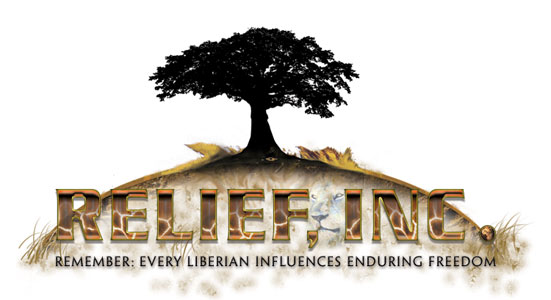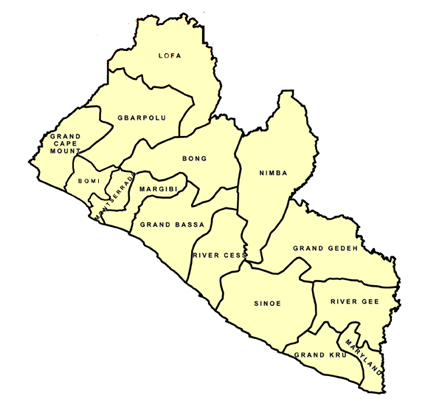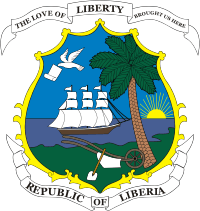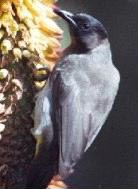
Liberia was founded my American slaves in 1847
Country Name: Republic of Liberia
Capital: Monrovia
Independence: July 26. 1847
Government Type: Republic (Legislative, Executive & Judicial Branch)
Legal System:
Dual system of statutory law base on Anglo-American common law for the modern sector and customary law based on unwritten tribal practices for the indigenous sector.
The Liberian Flag:
 The Liberia’s national flag is called “LONE STAR”. The eleven horizontal stripes represent the eleven signers of the declaration of independence and the constitution of the Republic of Liberia; the blue field symbolizes the continent of Africa; the five pointed white star depicts Liberia as the first “independent republic” on the continent of Africa; the red color designates “valor”; the white, “purity”; and the blue, “fidelity”. Although these representations are uniquely Liberian, the flag itself is a replica of “Old Glory”, the national flag of the United States.
The Liberia’s national flag is called “LONE STAR”. The eleven horizontal stripes represent the eleven signers of the declaration of independence and the constitution of the Republic of Liberia; the blue field symbolizes the continent of Africa; the five pointed white star depicts Liberia as the first “independent republic” on the continent of Africa; the red color designates “valor”; the white, “purity”; and the blue, “fidelity”. Although these representations are uniquely Liberian, the flag itself is a replica of “Old Glory”, the national flag of the United States.
The American Colonization Society: The Founder of Current Day Liberia:
American Colonization Society, organized Dec, 1816-Jan. 1817, at Washington, D.C., to transport free blacks from the United States and settle them in Africa. The freeing of many slaves, principally by idealists, created a serious problem in that no sound provisions were made for establishing them in society on an equal basis with white Americans anywhere in the United States. Robert Finley, principal founder of the colonization society, found much support among prominent men, notably Henry Clay.
Money was raised-with some indirect help from the federal government when (1819) Congress appropriated $100,000 for returning to Africa blacks illegally brought to the United States. In 1821 an agent, Eli Ayers, and Lt. R.F. Stockton of the U.S. Navy purchased land in Africa, where subsequently Jehudi Ashmun and Ralph R. Gurley laid the foundations of Liberia. More than 11,000 blacks were transported to Liberia before 1860.
From 1865 until its dissolution in 1912, the society was a sort of trustee for Liberia.
Beginning in 1989, Liberia was plagued by years of civil unrest. In 1987, Charles Taylor and his National Patriotic Party (NPP) won the elections. The years of civil turmoil have been very disruptive to Liberia’s growth, and the country was faced with the challenging task of rebuilding societal and economic structures ravaged by the war.
After a 14 ½ years of civil war, Liberia held presidential election in October 2005, Harvard-educated Mrs. Ellen Johnson –Sirleaf was elected Liberia’s 23rd president in a runoff election with Mr. George Weah, an international soccer star. The United Nations Mission in Liberia (UNMIL), which maintains a strong presence throughout the country with over 15,000 troops, completed a disarmament program for former combatants in late 2004, but the security situation is still volatile and the process of rebuilding the social and economic structure remains sluggish.
LIBERIAN GEOGRAPHY

AREA:
Total: 111,370 sq km
Land: 96,320 sq km
Water: 15,050 sq km
LAND BOUNDRIES:
Total: 1,586 km
Border countries:
- Guinea 563 km
- Cote d’lvoire 716 km
- Sierra Leone 306 km
COASTLINE: 579 km
CLIMATE:
Tropical; hot, humid; dry season with hot days and cool to cold nights;
wet, cloudy rain season with frequent heavy showers.
Rainy Season: May to October
Dry Season: November to April
TERRAIN:
Mostly flat with rolling coastal plains rising to rolling plateaus and low mountains in the northeast.
Lowest point: Atlantic Ocean 0 m
Highest point: Mount Wuteve 1,380 m
NATURAL RESOURCES:
Iron ore, timber, diamonds, gold, hydropower, rubber, and coffee, cocoa and cotton.
GEOGRAPHY-NOTE:
Facing the Atlantic Ocean, the coast-line is characterized by lagoons, man-grove swamps, and
river-deposited sandbars; the inland grassy plateau supports limited agriculture.
POPULATION: 3,482,211 (July 2005 est.)
AGE STRUCTURE (2005 est.)
1-14 years: 43.6% (male 765,662/female 751,134)
15-64 years: 52.8% (male 896,206/female 940,985)
65 years and over: 3.7% (male 64,547/female 63,677)
LIFE EXPECTANCY AT BIRTH:
Total pop: 38.89 years /male: 37.03 yrs
Female: 40.81 yrs (2005 est.)
ETHNIC GROUPS:
Indigenous African tribes 95% (including Kpella, Bassa, Gio, Kru, Grebo, Mano, Krahn, Gola, Gbandi, Loma, Kissi, Vai, Dei, Bella, Mandingo, and Mende). Americo-Liberians 2.5% (descendants of immigrants from the US who had been slaves). Congo People 2.5% (Congo people from the Congo River Bassin who were captured for the slave trade but sent to Liberia when slavery was abolished with never being exposed to Non-African cultures.)
RELIGIONS: Indigenous beliefs 40%, Christian 40%, Muslim 20%
LANGUAGES:
English 20% (official), some 20 ethnic group languages, of which a few can be written and are used in correspondence.
NATIONAL SYMBOLS

The Seal of Liberia (Coat of Arms): The national Seal consists of a palm tree representing the natural resources of Liberia; a plow and spade which illustrate the means of developing those resources; a dove with a scroll which represents communication and living in peaceful coexistence with other nations; the emerging sun which represents the birth of Liberia; a sailing ship representing arriving settlers; and the motto "The Love of Liberty Brought Us Here" also represents the wishes, dreams, and hopes of arriving settlers.

Pepper bird: The Liberian national bird is the Pepper bird. It is called the Pepper bird because of its primary diet of wild peppers.
STAPLE FOODS
Rice: Sold in 100 lbs bags or by the cup.
Variety includes ‘Pusawah Rice’
and ‘White Rice’ served with most dishes.
Palm Butter: Spicy sauce made from
palm cream. A favorite of Liberians!
Some may include “snail” and
“Kiss meat” in Preparation.
Cassava Leaf: Leafy sauce made with palm oil.
Palava Sauce: Slimy but delicious sauce made
also with palm oil. Usually embellished with
smoked fish, dried meat, chicken, pig feet.
Jollof Rice: Standard holiday dish.
Made by combining tomato paste, rice,
and a variety of meats.
Pepper Soup & Fufu: Tasty and usually very hot and very spicy soup made with a variety of meats and pepper. Served mostly to guests at the end of house parties Fufu, may or may not be included. Fufu is a thick, gel-like dish made from ground cassava (yucca) or potatoes.
Potato Greens: very tasty and leafy dish.
Made with vegetable or palm oil.
Fish Gravy: Can’t go wrong with this simple dish.
Served with rice, fried or boiled fish, and a delicious
gravy sauce.
Okra Sauce: Sauce made from okra served with rice.
Torborgee: Another favorite, but not for the faint hearted.
Taste is an acquired one. Bitter yet very tasty. Made with variety of meats and palm oil.
Cabbage: Sauce made from palm cabbages. Cabbage
are cut into small pieces and cooked with diced turkey
or pork. It’s very healthy and delicious.
Collard Greens: Another healthy dish. Difficult and delicate preparation (thick stems of greens are slowly diced by hand). But the wait is well worth it.
Kala: Donut-hole like snack made from fried dough.
Rice Bread: Served as a baked desert or
snack. Made with banana, corn, flour.
Plantain: Standard Liberian snack.
boiled and served with palm oil, sliced and fry as a snack.
NATIONAL HOLIDAYS
| NEW YEAR DAY: January 1 |
NATIONAL REDEMPTION DAY: April 15th |
|
| CONSTITUTION: 2nd Wednesday in March |
INDEPENDENCE DAY: July 26th (1847) |
|
| DECORATION DAY: 2nd Wednesday iin March |
FLAG DAY: August 24th |
|
| J.J. ROBERTS BIRTHDAY: 1st President of Liberia - March 15th |
THANKGIVING DAY: 1st Thursday in November |
|
| FAST & PRAYER DAY: 2nd Friday in April |
W.V.S. TUBMAN BIRTHDAY: November 29th |
|
| NATIONAL UNIFICATION DAY: April 14th |
CHRISTMAS DAY: December 25th |
